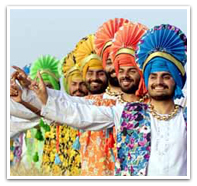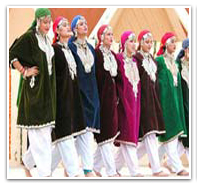The all time fertile land of five rivers is Punjab. The land of the dare devil Sikh community. The religion was born to save the motherland and the Sikhs and the Punjabis, ready to take any risk, accepted it. India has been represented by the Sikh community venturing out for business to far fledged lands, more than anyone else from India.
The state is full of surprises and is known as the paradise of India. Jammu and Kashmir are actually the crown of India, the northern most state. The mystic Leh, the beautiful valleys of Kashmir and the huge Shrines of Jammu, comprise a treat for the traveler. Followers of Islam, Buddhism and the Hindus, all stay in peace in this state blessed with natural abundance. The great Himalayan mountain range forms a superb background to this unique state.
All the Hindu, Muslim, Sikh and Buddhist festivals are celebrated here with all the enthusiasm and vibrancy. Vaitha-Vatur-Truvah which literally means thirteenth day of source of River Jhelum. It is held at an ancient temple at Verinag, the source of the Jhelum. Hindus and Muslims participate in this festival.
Himachal Pradesh, known as the abode of Gods is another picturesque region of Northern India. The people of this region based on the foothills of Himalayas are religious and celebrate their festivals with gaiety and pomp. The Phulaich festival celebrated in the Kinnaur district in month of September is unique in tradition. This four day festival is celebrated as the flower festival by the people of Himachal. The Rajputs of the village go to pluck flowers from a specified mountain and return only the next day. The night is spent singing and dancing. On the third day, the village deity is taken out and bedecked with all the finery along with the numerous flowers. A procession is taken out and the rests only the next day when an animal is sacrificed. Although this is a beautiful festival, the more famous and promoted is the Dushera of Kullu. Dushera is celebrated all around India, but not like that in Kullu. The celebrations start in Kullu when the celebrations of India for Dushera finish. The presiding deity of Kullu, Raghunathji is taken out on this day and around 600 deities of Himachal come to pay respect to this deity. Huge colourful processions mark the occasion and by the end of the festival the Lord is bathed in the Beas River and then taken back to its main temple. Singing and Dancing and worshipping is the core of this festival celebrated with pomp and show.
The state of Haryana is full of greenery and the places in Haryana are ancient having a mention in the Mahabharata. Due to the proximity to Delhi, some places in Haryana like Gurgaon and Faridabad have recently gained extreme importance as the satellite towns of Delhi and have been added to the list of the National Capital Region. All the common festivals like Holi, Diwali and Dushera are celebrated in the state. But the Haryanavis celebrate two important festivals with great fervour. Teej festival is celebrated during the month of July – August, to welcome the month of Sawan, bringing rains. Mainly ladies and girls enjoy this festival more than the men folk. The dupattas in bright red or pink with beautiful motifs of golden thread are worn, swings are hung on trees to play with and henna is applied on palms. A colourful festival, where the girls and the married ladies worship Lord Shiva and Parvati. Sanjhi is another important festival celebrated and worshipped as the mother goddess by unmarried girls of Haryana. They make the image of Sanjhi with mud using various shapes. These shapes include stars, moon, sun, face of the goddess and are then coloured. The festival takes place in early October or late September and the art associated with the festival is unique and very naïve. Gangore is celebrated around March -April. Idols of Ishar and Gangore are taken out in procession and songs in their praise are sung till they are immersed into water. This spring festival is held in honor of Gauri, the goddess of abundance.
Uttar Pradesh – the most populous states of India is also one of the most ancient cradles of Indian culture. Two great Rivers along with one mythological river that of Saraswati flow through this state. Abundant with natural wealth and resources, Uttar Pradesh ahs given India most of its Prime Ministers. The common Hindu festivals of Diwali, Dushera and Muslim festivals like the Ids are celebrated with vigour over here. The state wears a vibrant colour throughout the festivities. Some unique festivals to Uttar Pradesh includes the most famous, Lathmar Holi.
48 km. from Mathura at Barsana, is celebrated the famous Lathmar Holi of Braj. Tradition has it that Krishna from Nandgaon use to come to Barsana to play Holi with Radha along with his Gopi friends. The Gopis after merriment chased them away by beating them with lathis or big bamboo sticks. Hence the name. To this day, the village women beat up the men from Nandgaon and chase them away.
The month long Kumbh Mela of Allahabad is one of the largest fairs of the world and is attended by millions of pilgrims from all over India as well as the devout from the world over. This religious occasion takes place in the months of January-February, on the banks of the holy confluence of rivers Ganga, Yamuna and the mythical Saraswati. It is believed that a holy dip on this occasion washes all the sins. There is annual Kumbh, six yearly and the most important is the one that comes every twelve years.
The beautiful Kartik Purnima festival or the Dev Deepawali celebrated in Varanasi or Benaras, is a visual delight. Varanasi is the land of festivals. The full moon night after Diwali falling in November – December is the sacred day for all the people. The ghats of Varanasi come alive with thousands of brightly lit earthen lamps. The lamps then are gently left on the River. Visitors throng in large numbers to watch this spectacular event.
Other important festivals celebrated in the Uttar Pradesh are the Ramnavami at the birth place of Ram, in Ayodhya and Janmashtami, at the place of Krishna in Mathura. These festivals are celebrated with great pomp and show in these two places as compared to other places in India.
The land of celestial beauty that is what the new state of Uttaranchal is all about. Blessed with magnificent glaciers, majestic snow-clad mountains, gigantic and ecstatic peaks, valley of flowers, skiing slopes and dense forests, Uttaranchal is traveler delight and also a pilgrimage site for the Hindus, nestling the four most sacred places of Badrinath, Kedarnath, Gangotri and Yamunotri in its mighty mountains and deep valleys. The Mata Murti Ka Mela held in the Champavat region in September is the unique festival. On this day the mother of Badrinath is worshipped, and a large fair held at the Badrinath Temple. Among the four sacred places of India where the Kumbh is held, one of them is Haridwar in Uttaranchal. The Magh Mela during Sankranti in the Kumaon region is another important festival.

